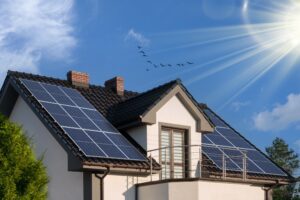How Much Does Loft Insulation Cost?
We rarely if at all think about that seldom-used space at the top of the house quietly gathering dust and providing a cosy home for spiders. However, your uninsulated loft could be costing you hundreds of pounds a year, potentially losing a quarter of your home’s heat through the roof.
Insulating your loft or attic space is a highly cost-effective energy efficiency measure that minimises heat loss during colder weather and prevents hot air from entering your living space in the summer months. This helps cut energy costs and lessens environmental impact by reducing carbon emissions.
The problem for many homes is that they have loft space with no insulation, or even if it is present, the insulation may be insufficient to be effective.
In this guide to typical loft insulation costs, we’ll also take you through everything you need to know about insulating your loft. You may even be able to get it installed for free or for minimal cost.
How Does Loft Insulation Work?
Loft insulation is one of the simplest ways to improve your home’s energy efficiency and lower heating costs. Hot air naturally rises because it’s less dense than cooler air. In your home, the warm air produced by your heating system will continue its upward trajectory into your loft or attic, making the rest of your home colder.
The solution is simple: loft insulation. It makes your home more energy efficient by reducing the flow of thermal energy.
Lofts are commonly insulated by installing padding on the loft floor. This is known as cold loft insulation. The insulation material is laid between and across the floor, and joists to keep heat in the main part of your home instead of allowing it to pass into the loft. You should also add insulation over the loft hatch to boost energy efficiency performance.
Loft Insulation Materials
There are various loft insulation options, characterised by the insulating materials used.
Insulation Rolls
The most common type of loft floor insulation and usually the least expensive comes in blanket rolls of materials including:
- Sheep’s wool is readily available and a good eco option.
- Glass mineral wool is a particularly eco-friendly option made from sand and recycled glass.
- Rock mineral wool is made from volcanic rock and/or waste products from blast furnaces.
Other types of loft insulation include:
Loose-Fill Insulation
Loose-fill loft insulation uses a lightweight material such as mineral wool, cork, or cellulose fibre. Granules of these materials are poured between joists. A disadvantage of this method is that it’s not very secure and can be messy.
Blown-Fibre Insulation
Blown-fibre insulation entails blowing mineral fibres between the loft floor or roof joists. The fibres bond together to create a foam-like effect. This is handy for hard-to-reach areas but doesn’t offer a complete insulation solution. It’s also expensive.
Spray Foam Insulation
Spray foam insulation contains compounds that expand after application to create a thermal barrier. It’s more expensive than most other types of loft insulation and can cause some issue when installed in certain properties. It is also messy and difficult to remove once installed. Effective Home do not install this type of insulation, nor do we recommend it.
Loft Insulation Boards
Rigid insulation boards consisting of natural or synthetic materials can be fitted between or over both loft rafters and joists. They can be a good choice for large lofts but are often more expensive than insulation rolls. However, the boards provide a surface you can walk on and use for additional storage.
Installing Boards Over an Insulated Loft Floor
If you use material such as mineral wool to insulate your loft floor, you can still turn your loft into a more useful space by covering it with conventional, less costly boards. But you need to ensure the boards are fitted with a space between them and the insulation material. This is essential for ventilation to avoid condensation.
If the insulation material comes up over the floor joists, a subframe will need to be installed to raise the level of the boards.
Topping Up Loft Floor Insulation
Even if your loft floor has been insulated with quality material, there may not be enough of it, especially if you live in an older property with old loft insulation. How much loft insulation you need, will be dependent on when your loft insulation was originally installed (if any actually was).
Before 1995, for example, the recommended depth for loft insulation was less than 200mm, compared with today’s standard of 270mm.
Adding more insulation material on top of your existing insulation can make quite a difference in the long term, saving an additional £25 a year on energy bills and further reducing your carbon footprint.
Keep in mind that various issues can render loft insulation ineffective over time, so you need to make sure the existing insulation is in good condition. Doing this will ensure the top-up insulation achieves optimal performance.
How Much Does Loft Insulation Cost?
Various considerations determine loft insulation prices, including:
- Type of insulation material.
- Amount of insulation needed.
- Whether removal of old insulation is necessary.
- Loft accessibility – difficult access complicates the job, which can increase installation costs.
According to the Energy Saving Trust, the average loft insulation costs are in the region of:
- £880 for a mid-terrace house.
- £930 for a semi-detached house.
- £1,200 for a detached house or detached bungalow with loft space.
The average loft insulation cost depending on the materials used are typically around:
- Blanket insulation or quilt insulation – £5 per square metre.
- Loose-fill insulation – £7.50 a square metre.
- Insulation boards – £10 a square metre.
- Blown-fibre insulation – £55 per square metre.
- Spray foam insulation – up to £90 a square metre.
Blanket Roll Loft Insulation Costs
The most common way of insulating a loft is with blanket roll material to the recommended depth of 270mm. This typically costs:
- Terrace house – £550.
- Semi-detached house – £670.
- Detached house – £930.
No VAT on loft insulation installations
VAT on professional loft insulation installation is currently zero-rated. After March 2027, it’s expected to revert to its reduced rate of 5%.
How Much Money Will Installing Loft Insulation Save Me?
Installing loft insulation can save households hundreds of pounds on energy bills year after year.
According to Energy Saving Trust estimates (and based on April 2024 fuel prices), loft insulation can bring annual energy bills savings:
- £370 for a detached house.
- £360 for a detached bungalow.
- £225 for a semi-detached house.
- £200 for a mid-terrace house.
You may be eligible for a grant to get free loft insulation or to install loft insulation at reduced cost.
Loft Insulation Grants
Free loft insulation grants to cover all or part of the cost of professional loft insulation are available, mainly from the government-backed Great British Insulation Scheme (GBIS).
You could be eligible for this funding, whether you own or rent your home, if the property:
- Has an Energy Performance Certificate (EPC) rating of D, E, F, or G.
- Is in Council Tax bands A to D in England or A to E in Wales and Scotland.
If anyone in your household gets benefits, you may qualify for additional financial support, up to 100% of the loft insulation cost.
Pensioners with an income below £31,000 a year can also get full or substantially discounted loft insulation funding.
The Great British Insulation Scheme was introduced in March 2023 to ease fuel poverty and reduce carbon emissions. The scheme is scheduled to run until March 2026.
Other grants to install insulation may be available from initiatives such as
- Local Authority Flexible Eligibility (LA Flex). Local councils have their loft insulation funding eligibility criteria for households on low income.
- Affordable Warmth Scheme. This can cover the cost of loft insulation if your household income is less than £20,000 a year.
- Home Upgrade Grant (HUG). This scheme pays for loft insulation for homeowners in certain postcode areas in England off the gas grid if they have an annual income of £31,000 or less and an Energy Performance Certificate rating of D to G.
Dangers of DIY Loft Insulation
It may be tempting to try insulating your loft yourself in an attempt to cut costs. But unless you’re an expert, experienced DIY devotee, professionally installed loft insulation will be the safest (and cleanest) recommended option.
There are good reasons for not attempting loft insulation. It’s a messy job that involves heights, small spaces, and sharp cutting implements. Lofts typically present several physical hazards, including irritants floating about in the air. Protruding nails or screws can pose a risk of injuries. Getting into the loft in the first place can also be a risk.
You’ll also need personal protective equipment (PPE) such as overalls, knee pads, some form of head protection, safety goggles, protective work gloves, and a face mask to prevent inhalation of dust and fibres. If your loft floor has open joists, you’ll also need some type of crawl board to spread your weight to avoid plummeting through the ceiling below.
Even if you can take all the necessary safety precautions, you’ll then be faced with the technical complexities of loft insulation. Measuring and cutting loft insulation material to size should be done in the loft itself, even if space is tight. This avoids loose fibres spreading throughout your living space. However, this can be difficult on your own, which is why professionals work in teams.
Benefits of Professional Loft Insulation
Insulating a loft can be a daunting, time-consuming, messy, and potentially dangerous job even for a seasoned DIY enthusiast. Doing it yourself to save on loft insulation labour costs, but this can also easily backfire, with results that do little to improve your home’s energy efficiency or lower heating costs.
Professional loft insulation installers, on the other hand, can safely work fast with minimal disruption to your home. They have the specialist skills and the right equipment and materials to ensure an installation that provides optimal energy efficiency to maximise savings.
Advantages of Loft Insulation
Loft insulation is an energy-efficient investment that pays households back in dividends.
It does its job quietly, invisibly and efficiently, is maintenance-free, and will start saving you money almost immediately.
Insulating your loft is the single most effective measure you can take to ensure heat stays where you need it – in your living space. The relatively low cost of loft insulation means it’s a good starting point to make your home more comprehensively thermally efficient.
During winter and other colder months, loft insulation forms a barrier that prevents warm air from escaping your house too fast. The more effective that barrier, the more heat your home retains.
In the warmer months of spring and summer, loft insulation does the opposite. It keeps your home cool and comfortable by preventing warm air from getting into your living space.
According to the Energy Saving Trust – an independent organisation that promotes energy efficiency – a properly insulated loft can:
- Pay for itself many times over during its 40-year lifespan.
- Cut heating bills by up to almost £370 a year.
- Increase the value of a home by 14%
Although not a soundproofing measure in itself, loft floor insulation can reduce the level of footfall and other noises heard in bedrooms below a converted loft.
Cold Loft Insulation Vs Warm Loft Insulation
The terms cold loft insulation and warm loft insulation can be misleading. The temperature of a “warm loft” is easier to control, while a “cold loft” can be hot in summer as well as cold in winter.
Cold loft insulation – also called cold roof insulation – is the most common type of loft insulation, with insulation materials fitted between and across the timber joists of the loft floor.
Installing insulation immediately above the ceiling of the top part of your living space means no heat from your home gets into the loft. It’s a good solution if, as in many cases, your loft is used only for storage space, provided the stored items are unaffected by temperature extremes.
Warm loft insulation – or warm roof insulation – could be a better option if you use your loft regularly, need to store items at a stable temperature, or are planning a loft conversion. This type of loft insulation is applied between and across the timber rafters of the roof and reduces heat loss in the same way as cold loft insulation but keeps the loft space at a comfortable temperature as well.
On the downside, warm loft insulation is more complex and more expensive, and the risk of causing condensation problems is increased.
Another point to bear in mind is that your energy bills will generally be higher with warm loft insulation. Heat from lower areas of your home will escape into the loft space, so your heating system will need to work that bit harder to keep you warm.
Does My Loft Need Insulating?
Homes in the UK have low levels of insulation in general compared with the rest of Europe. Nearly a quarter of lofts in UK homes are uninsulated and many others have lofts that are inadequately insulated.
In new-build UK properties, the statutory minimum depth of loft floor insulation is 270mm. However, if your home was built after 2003 your loft insulation is likely to be substandard. Homes built in 1965, for example, only needed loft floor insulation to be 25mm thick.
There are several signs your loft may be uninsulated or has inadequate insulation. These include a cold house or unusually high energy bills because you’re having to crank up the heating to compensate for heat loss.
But the most obvious indications your loft needs insulating will be revealed by inspecting the loft.
How to Check Your Loft Insulation
If your loft is easily accessible, you can check whether it’s been insulated or if the existing loft insulation is sufficient.
It’s advisable to wear sturdy gloves, a face mask, and eye protection before handling any insulation material between the floor joists.
Things to check include
- Depth of the existing insulation material. Some insulation is better than none but it should be at least 270mm thick.
- Condition of the insulation material. If it’s started to fall apart or become mouldy, this will reduce insulation performance.
- Standard of insulation installation. Look for gaps that allow draughts, and air vents that have been covered. These installation faults will not only impact insulation performance but also result in condensation.
Can’t Get into Your Loft?
According to research, almost one-third of homeowners never venture into their loft. If access to your loft is difficult, or you simply don’t like the idea of going up there, a visual inspection of your roof from the ground may indicate loft insulation issues.
If birds seem to be drawn to your roof in numbers in cold weather, it’s likely because they favour warm surfaces that conserve their body heat. In other words, they’re making the most of the heat escaping from your home through the roof.
Another sign of heat loss from your loft may be seen after snowfall. Does your roof remain icy after snow on your neighbours’ roofs has melted away? If it does, your roof is warmer because heat is escaping from your home.
Your home’s Energy Performance Certificate could also help you figure out whether your loft needs insulating. An EPC rates a property’s energy efficiency alphabetically, from A (the most efficient) to G (the least efficient). A poor EPC rating can often be related to a lack of or inadequate loft insulation.
However, the best way to determine how much insulation, if any, your loft needs, is to call in a professional loft insulation company.
Effective Home has been insulating lofts in homes throughout the UK for many years. We use the most advanced insulation techniques and materials, not cheap loft insulation materials, to ensure long-lasting results that maximise the benefits and savings. We also provide a 25-year guarantee. Furthermore, we can help you apply for funding that may mean free or cheaper insulation.
Call us on 0333 003 0703 or contact us online to arrange a free, no-obligation loft insulation survey.



